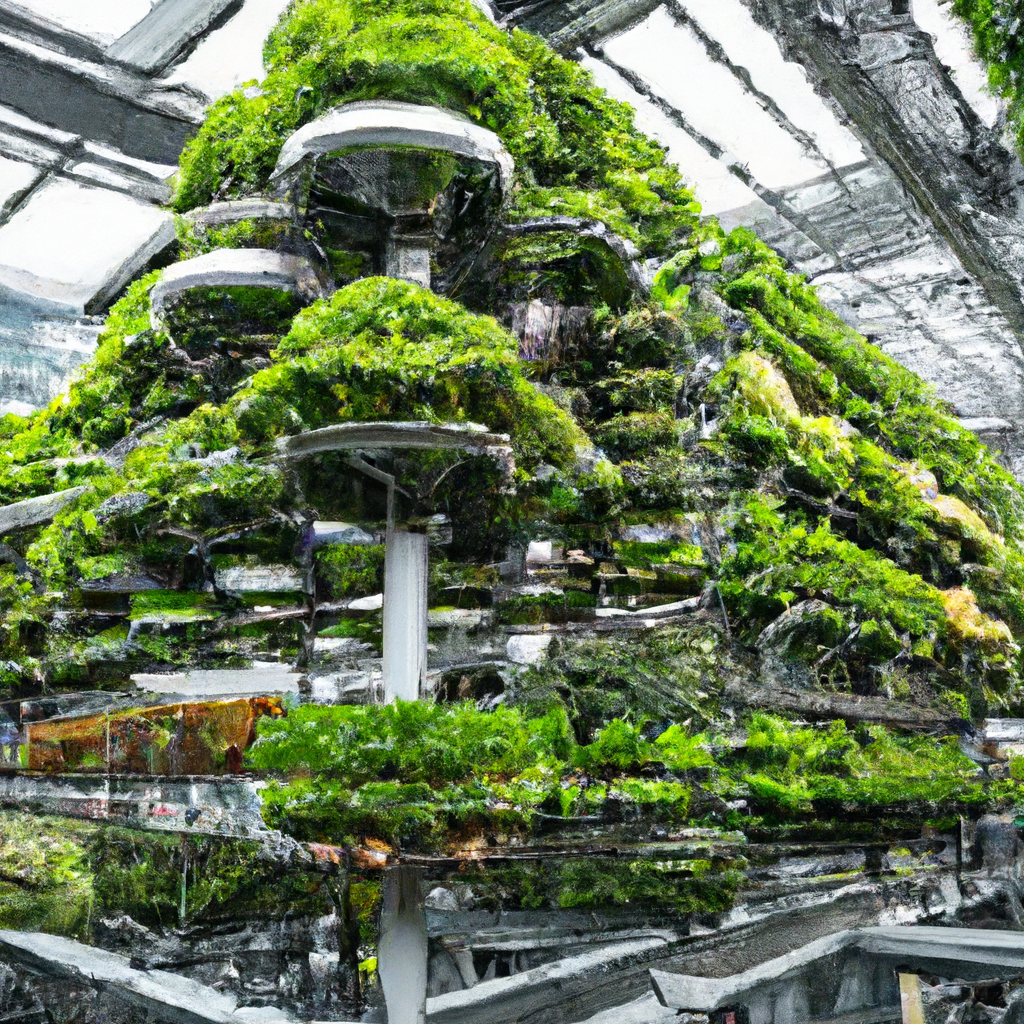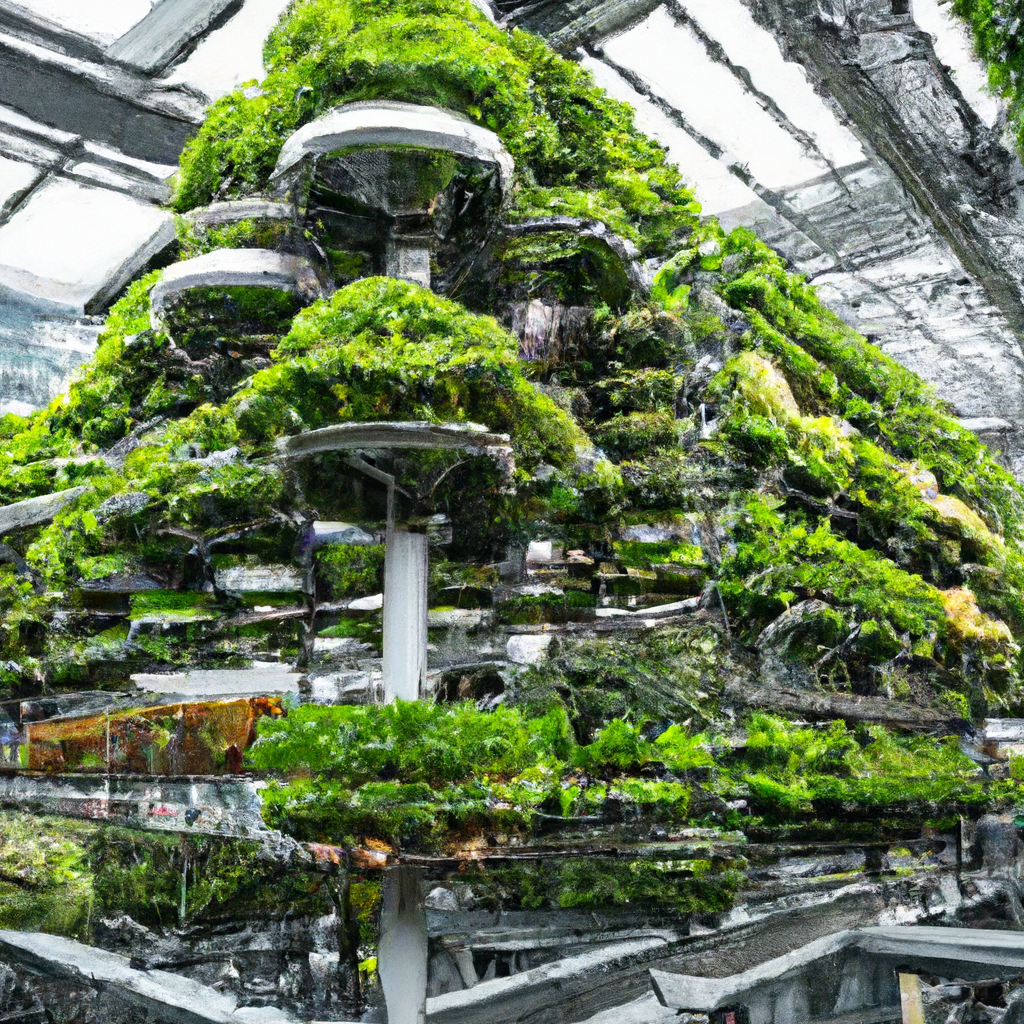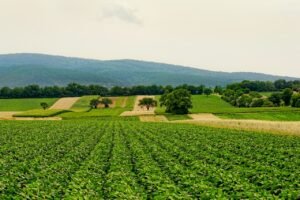
Imagine a world where agriculture is not limited by land scarcity or unpredictable weather conditions. Vertical farming, a revolutionary technique, allows plants to be grown in vertically stacked layers, utilizing artificial lighting and controlled environments. This innovative method offers numerous advantages, such as increased crop yield, reduced water usage, and year-round production. With vertical farming, the potential to feed a rapidly growing global population becomes a reality, making it a game-changer in sustainable agriculture.

Increase in Crop Yield
Optimal use of space
Vertical farming allows for the efficient use of space by utilizing vertical stacking systems. With multiple layers of crops grown on shelves or racks, the available growing surface area is maximized. This means that more plants can be grown in a smaller footprint compared to traditional horizontal farming methods. By utilizing the vertical space, farmers can significantly increase their crop yield per square foot.
Year-round crop production
In vertical farming, crops are grown indoors in controlled environments, eliminating the dependence on seasonal changes. This enables year-round crop production, regardless of the climate or weather conditions outside. By providing a stable and consistent environment for plants to grow, farmers can optimize the growth and development of crops, leading to higher yields throughout the year.
Multiple crop cycles
Vertical farming allows for multiple crop cycles within a single year. Since the growing conditions can be tightly controlled, farmers can quickly rotate crops and start new cycles as soon as the previous one is harvested. This rapid turnover enables farmers to maximize their harvests and increase overall productivity. Instead of waiting for the next planting season, vertical farmers can continuously grow and harvest crops, resulting in a more efficient use of time and resources.
Elimination of weather restrictions
Traditional farming is vulnerable to extreme weather events such as droughts, floods, and storms, which can severely impact crop yields. In vertical farming, crops are shielded from outdoor weather conditions, minimizing the risk of crop failure due to unpredictable weather patterns. By eliminating weather restrictions, vertical farming provides a reliable and consistent environment for crop growth, ensuring a higher level of crop productivity and reducing the risk of yield losses.
Conservation of Resources
Reduces water consumption
In vertical farming, water is used more efficiently compared to conventional farming methods. The closed-loop irrigation systems in vertical farms recirculate water, minimizing wastage and reducing overall water consumption. Additionally, vertical farming techniques, such as hydroponics, use less water compared to soil-based agriculture. By conserving water resources, vertical farming helps to alleviate the pressure on freshwater sources and promotes the sustainable use of this precious resource.
Minimizes land usage
Vertical farming requires significantly less land compared to traditional farming practices. By utilizing vertical space, farmers can grow a large quantity of crops within a small physical area. This vertical stacking of crops allows for the production of food in urban areas where land is limited. By minimizing land usage, vertical farming helps to preserve natural habitats, protect agricultural land from urban sprawl, and reduce deforestation.
Decreases energy requirements
While vertical farming utilizes artificial lighting and climate control systems, advancements in technology have made these energy inputs more efficient over time. Modern LED lighting systems, for example, are designed to provide the optimal spectrum and intensity of light for plant growth while consuming less energy. Additionally, vertical farming systems can be integrated with renewable energy sources such as solar panels, further reducing the carbon footprint. By decreasing energy requirements, vertical farming contributes to the overall sustainability of the agricultural sector.
Eliminates pesticide use
In a controlled indoor environment, vertical farming greatly reduces or eliminates the need for pesticides. The controlled conditions minimize the risk of pests and diseases, reducing the reliance on chemical pesticides. Additionally, vertical farming can incorporate integrated pest management techniques, such as biological controls, to naturally address any pest issues. By eliminating the use of pesticides, vertical farming ensures the production of safer and healthier food while reducing the negative environmental impacts associated with chemical pesticide use.

Improved Food Safety
Controlled environmental conditions
Vertical farming provides a controlled environment where factors such as temperature, humidity, and air quality can be precisely regulated. These controlled environmental conditions minimize the risk of contamination by pathogens and reduce the potential for foodborne illnesses. By implementing strict quality control measures, vertical farmers can ensure that the produce meets the highest food safety standards, providing consumers with safer and healthier food options.
Reduced risk of contamination
Vertical farming reduces the risk of contamination compared to traditional farming practices. By growing crops indoors, vertical farmers can isolate the plants from external sources of contamination, such as air pollution, industrial chemicals, and wildlife droppings. Furthermore, vertical farms can implement stringent sanitation protocols to maintain a clean and hygienic growing environment, further reducing the risk of contamination throughout the production process.
Avoidance of chemical additives
In vertical farming, the controlled environment allows for the production of crops without the need for chemical additives. With optimal growing conditions and careful monitoring, crops can fully develop their natural flavors and nutritional content, eliminating the need for synthetic additives such as artificial ripening agents or preservatives. By avoiding chemical additives, vertical farming ensures that the produce is free from potentially harmful substances, promoting a healthier diet and reducing the reliance on processed foods.
Traceability of produce
Vertical farming systems often employ advanced technology and data tracking systems to monitor the growth and production process. This allows for strict traceability of the produce from seed to harvest. By tracking the entire lifecycle of the crops, consumers can have confidence in the origin and quality of the food they consume. This transparency in the supply chain enhances food safety and helps build trust between producers and consumers.
Enhanced Nutrient Content
Optimized growing conditions
Vertical farming provides the ability to tailor growing conditions to the specific needs of each crop. By optimizing factors such as lighting, temperature, and nutrient delivery, vertical farmers can create an ideal environment for plant growth. This precision farming approach ensures that crops receive the necessary nutrients at the right time, resulting in enhanced nutrient absorption and overall improved nutritional content.
Precise nutrient delivery
In vertical farming, nutrient solutions are provided directly to the plant roots through hydroponic or aeroponic systems. This precise delivery method allows for better control and optimization of nutrient uptake by the plants. By eliminating the competition for nutrients present in soil-based agriculture, vertical farming ensures that the crops receive the essential nutrients they require for healthy growth. This precise nutrient delivery also enables the production of nutrient-dense crops with increased levels of vitamins and minerals.
Consistent quality of produce
Vertical farming offers consistency in crop quality due to the controlled growing environment. By eliminating the variability caused by changing weather conditions, farmers can produce crops with consistent taste, texture, and appearance throughout the year. This consistency is especially important for commercial growers who seek to meet consistent consumer demands and build brand loyalty. The ability to consistently provide high-quality produce enhances consumer satisfaction and promotes the consumption of nutritious and flavorful fruits and vegetables.
Potential for biofortification
Vertical farming presents an opportunity for biofortification, a process in which nutrient levels in crops are increased to address specific nutritional deficiencies. Through precise nutrient delivery, vertical farmers can supplement crops with essential vitamins and minerals, ensuring that consumers receive adequate dietary intake of key nutrients. This potential for biofortification in vertical farming has significant implications for addressing nutrient deficiencies and promoting public health.

Shorter Supply Chains
Local production and distribution
Vertical farming allows for localized food production and distribution. By establishing farms in urban areas, produce can be grown closer to consumer markets, reducing the distance traveled from farm to plate. This localized supply chain minimizes the time and resources required for transportation, leading to fresher and more nutritious produce reaching the consumers. Furthermore, by reducing the reliance on long-distance transportation, vertical farming contributes to the reduction of greenhouse gas emissions associated with food logistics.
Reduced transportation distances
The shorter supply chains in vertical farming significantly decrease transportation distances compared to conventional farming practices. Instead of relying on produce shipped from distant regions or even other countries, vertical farming enables crops to be grown within the community or nearby urban areas. This reduction in transportation distances not only reduces the carbon footprint but also preserves the freshness, flavor, and nutritional value of the produce, ensuring that consumers have access to high-quality food.
Fresher and more nutritious produce
The proximity of vertical farms to consumer markets allows for the delivery of fresher and more nutritious produce. Since the crops are harvested and delivered locally, there is a minimal time lag between harvest and consumption. This means that consumers can enjoy produce at its peak freshness, retaining its optimal flavor and nutritional content. By providing access to fresh and nutritious food, vertical farming contributes to promoting healthier eating habits and improving overall public health.
Support for local economies
Vertical farming can provide economic opportunities for local communities. By establishing farms in urban areas, jobs are created, contributing to local employment rates and income generation. The localized production and distribution networks also support local economies by keeping spending within the community. Additionally, vertical farming can stimulate entrepreneurship and innovation, as individuals and businesses explore new ways to grow and market fresh produce. By supporting local economies, vertical farming helps build more sustainable and resilient communities.
Reduced Impact on Ecosystems
Preserves natural habitats
Vertical farming minimizes the need for large-scale land conversion for agriculture. By utilizing vertical space and maximizing the use of existing buildings or vacant spaces, vertical farms can reduce the pressure to clear natural habitats. This preservation of natural habitats helps maintain biodiversity and supports the survival of native plant and animal species. By minimizing the ecological footprint, vertical farming contributes to the conservation of ecosystems and promotes a more sustainable coexistence with nature.
Limits deforestation and habitat destruction
One of the main drivers of deforestation and habitat destruction is the expansion of agricultural land. However, vertical farming reduces the demand for new agricultural land, minimizing the need to clear forests or convert natural habitats for crop production. By limiting deforestation and habitat destruction, vertical farming helps to protect wildlife and preserve the delicate balance of ecosystems. This conservation effort is crucial for maintaining biodiversity and ensuring the long-term sustainability of our natural resources.
Minimizes water pollution
Traditional farming practices often involve the use of chemical fertilizers and pesticides, which can leach into water sources and cause pollution. In vertical farming, the closed-loop irrigation systems and precise nutrient delivery methods dramatically reduce the risk of nutrient runoff and water pollution. By minimizing water pollution, vertical farming helps to protect aquatic ecosystems, preserve water quality, and mitigate the negative impacts on marine life. This environmental stewardship contributes to the overall health and resilience of our ecosystems.
Decreases greenhouse gas emissions
Vertical farming has the potential to significantly reduce greenhouse gas emissions associated with agriculture. By growing crops indoors, vertical farms can operate in a more energy-efficient manner, utilizing LED lighting systems and optimizing climate control. Additionally, vertical farming can integrate renewable energy sources such as solar panels, further reducing the reliance on fossil fuels. By decreasing greenhouse gas emissions, vertical farming helps mitigate climate change and contributes to a more sustainable and resilient future.

Climate Resilience
Efficient use of resources
Vertical farming optimizes the use of resources such as water, energy, and land, resulting in greater efficiency compared to traditional farming methods. By using closed-loop irrigation systems, efficient lighting systems, and precision nutrient delivery, vertical farming minimizes resource wastage and ensures that resources are utilized to their fullest potential. This efficiency enhances the resilience of the farming system, making it less vulnerable to resource scarcity or fluctuations, and better able to withstand environmental challenges.
Protection against extreme weather events
Vertical farming provides a controlled environment that can withstand extreme weather events such as droughts, floods, or heatwaves. By growing crops indoors, farmers can mitigate the potential damage caused by these events, ensuring a more reliable food supply. The controlled conditions in vertical farms, such as temperature and humidity control, offer protection against environmental stresses and maintain optimal growing conditions even during adverse weather conditions.
Reduced vulnerability to climate change
Climate change poses significant challenges to traditional farming, including changes in temperature, rainfall patterns, and the emergence of new pests or diseases. Vertical farming, with its controlled environment, offers a more resilient alternative. By adapting to changing climatic conditions and implementing suitable adjustments to the growing environment, vertical farmers can continue to produce crops regardless of external climate variations. This reduced vulnerability to climate change enhances food security and promotes sustainable agriculture.
Increased food security
Vertical farming contributes to increased food security by offering a reliable and consistent food supply. The ability to grow crops year-round, despite external climate conditions, reduces the dependence on seasonal harvests and minimizes the risk of crop failures. Additionally, the localized nature of vertical farming allows for the production of food in urban areas, bringing fresh produce closer to consumers. The increased food security provided by vertical farming ensures that communities have access to nutritious food, even during challenging times or in areas with limited agricultural resources.
Integration with Urban Areas
Utilizes vacant or underutilized spaces
Vertical farming presents an opportunity to utilize vacant or underutilized spaces within urban areas. Buildings, warehouses, or even parking lots can be transformed into vertical farms, making productive use of urban spaces that would otherwise go unused. This repurposing of urban spaces allows for the integration of agriculture into city landscapes and brings food production closer to the consumers, reducing the need for long-distance transportation.
Increases access to fresh produce in cities
Vertical farming in urban areas increases access to fresh produce for city dwellers. By growing food in close proximity to urban centers, vertical farms reduce the distance between the farm and the consumer, ensuring that produce is harvested at the peak of freshness. This proximity translates into a shorter supply chain, minimizing the time between harvest and consumption. The availability of fresh and nutritious produce in cities promotes healthier eating habits and addresses the issue of food deserts, where access to fresh food is limited.
Provides green spaces in urban environments
Vertical farming not only produces food but also provides green spaces in urban environments. The presence of vertical farms contributes to a more aesthetically pleasing and psychologically beneficial urban landscape. These green spaces can improve air quality, reduce urban heat island effects, and create a sense of community engagement and connection with nature. Vertical farms can be designed to incorporate vertical gardens or rooftop green spaces, further enhancing the environmental and social benefits provided by the integration of agriculture in cities.
Promotes sustainable urban planning
The integration of vertical farming with urban areas promotes sustainable urban planning. By incorporating agriculture and food production within cities, vertical farming contributes to the development of more self-sufficient communities. The localized production and distribution networks reduce the reliance on long-distance transportation, alleviating traffic congestion and reducing carbon emissions. Furthermore, the integration of green spaces and the preservation of natural habitat areas within cities enhance the overall livability and sustainability of urban environments.

Employment Opportunities
Creation of jobs in urban areas
Vertical farming creates employment opportunities, particularly in urban areas where the farms are typically located. The establishment and operation of vertical farms require a diverse range of skilled workers, such as agronomists, horticulturists, engineers, and technicians. Additional job opportunities may arise in research and development, marketing, and distribution sectors related to vertical farming. By creating jobs in urban areas, vertical farming contributes to local economic development and improves the livelihoods of individuals and communities.
Demand for skilled workers in agriculture
Vertical farming relies on advanced technology and innovative farming methods, requiring a specialized skill set. As the vertical farming industry continues to grow, there will be an increasing demand for skilled workers who can operate and maintain the complex systems used in these farms. This creates opportunities for individuals seeking employment in the agriculture sector, particularly those with a background in technology, engineering, or biology. The demand for skilled workers in vertical farming contributes to the diversification of the labor market and bridges the gap between agriculture and technology sectors.
Diversification of the labor market
The emergence of vertical farming diversifies the labor market by offering alternative employment opportunities in the agricultural sector. Traditionally, agriculture has been associated with rural areas and manual labor-intensive practices. However, vertical farming requires a combination of agricultural knowledge and technical skills, attracting individuals with diverse backgrounds and expertise. This diversification of the labor market promotes innovation, cross-sector collaboration, and the exchange of ideas, contributing to a more dynamic and sustainable agriculture industry.
Support for local economies
Vertical farming supports local economies by generating income and stimulating economic activity. The establishment of vertical farms creates a market for agricultural supplies, equipment, and technology. Local businesses can benefit from partnerships with vertical farms, providing services such as transportation, packaging, or marketing. Additionally, the production of fresh and locally grown produce contributes to the development of a robust local food system, enhancing food security, and reducing dependence on external food sources. By supporting local economies, vertical farming helps build resilient and self-sufficient communities.
Potential for Vertical Integration
Integration with other sustainable practices
Vertical farming has the potential to be integrated with other sustainable practices, creating a comprehensive approach to agriculture and resource management. For example, vertical farms can incorporate renewable energy sources, such as solar panels or wind turbines, to power their operations. The waste generated from the farm, such as plant residues or nutrient-rich water, can be recycled and used for other purposes such as bioenergy production or soil improvement. By combining vertical farming with other sustainable practices, the overall environmental impact can be further minimized, promoting a more holistic and regenerative approach to agriculture.
Incorporation of renewable energy sources
To enhance sustainability, vertical farms can integrate renewable energy sources into their operations. Solar panels, wind turbines, or even geothermal energy can be utilized to power the lighting, heating, and cooling systems essential for plant growth. By reducing reliance on fossil fuels, vertical farming contributes to the reduction of greenhouse gas emissions and promotes the transition towards clean and renewable energy sources. The incorporation of renewable energy into vertical farming supports the global push towards sustainable and environmentally friendly practices.
Combining vertical farming with vertical housing
The concept of vertical farming can be combined with vertical housing, creating self-sufficient communities that integrate food production with residential spaces. Vertical farms and vertical housing can be designed to exist within the same building or complex, allowing residents to have easy access to fresh and locally grown produce. This combined approach maximizes the efficient use of space, enhances food security, and promotes sustainable urban living. By integrating vertical farming with vertical housing, communities can foster a strong connection between residents, food production, and a more sustainable way of life.
Development of self-sufficient communities
Vertical farming has the potential to foster the development of self-sufficient communities that can produce a significant portion of their food locally. By combining vertical farming with other sustainable practices, such as renewable energy generation, rainwater harvesting, and waste recycling, communities can reduce their reliance on external resources and build resilience. The integration of farming and food production into communities not only enhances food security but also contributes to social cohesion, education, and the overall well-being of the residents. Vertical farming empowers communities to take control of their food systems and create a more sustainable future.
In conclusion, vertical farming offers numerous advantages that can revolutionize the agricultural industry. From its ability to increase crop yield and conserve resources to its impact on food safety and nutrient content, vertical farming provides a sustainable and efficient solution to many of the challenges facing traditional farming practices. By reducing the environmental footprint, promoting food security, and supporting local economies, vertical farming holds tremendous potential in creating a more resilient and sustainable food system for the future.







